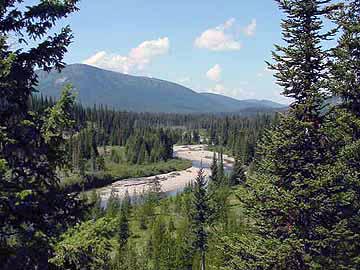A team of international scientists will visit Glacier National Park and its northern neighbor, Waterton Lakes National Park, in September to study risks that might be posed by coal mining in British Columbia not far from the parks.
The visit was called for back in June by the World Heritage Committee, an arm of the United Nations Educational, Scientific, and Cultural Organization, after the group was petitioned by a dozen groups from the United States and Canada, including the National Parks Conservation Association. At issue is a proposal by the Cline Mining Corp. to develop an open-pit coal mine in the landscape surrounding the headwaters of the Flathead River that flows south past Glacier National Park.
Tucked into British Columbia's southeastern corner, just about 25 miles north of Glacier and due west of Waterton Lakes, the Canadian Flathead Valley is a 40-mile swath of sawtooth-tipped mountains and alluvial plains that cradle the headwaters of the Flathead River. That ruggedness, with its resident grizzly bears, wolves, elk, lynx, mountain goat, wolverine and pristine fisheries of bull trout and Westslope cutthroat trout, has prompted one biologist to tag the area as "the single most important basin for carnivores in the Rocky Mountains."
The ecological value of the area wasn't overlooked -- but seemingly was ignored -- back in 1995 when the Waterton Lakes-Glacier was designated a World Heritage Site. Indeed, in its summary of the landscape the International Union for Conservation of Nature stated that, "the essential point is that the (Waterton-Glacier) unit is less complete in its coverage of the ecosystem than existing World Heritage Sites in the region. This could make the unit more prone to loss of species in the long run unless extra effort is made to manage cooperatively the public and private lands that adjoin the parks."
Taking a larger look at the landscape, the transboundary Crown of the Continent region, including the Flathead Valley, is one of the most intact, diverse and connected ecosystems in the temperate zones of the world. Characterized by remoteness and farsighted conservation practices, the core of the Crown of the Continent consists of transboundary land encompassing Waterton-Glacier International Peace Park, and Bob Marshall, Great Bear, and Lincoln Scapegoat Wilderness areas.
Against such a backdrop, the proposal by Cline Mining Corp. to sink an open-pit coal mine into the area could have devastating impacts on the Canadian Flathead Valley and those areas downstream in the United States, according to those who have looked into the matter.
On Tuesday, Interior Secretary Ken Salazar and U.S. Sens. Max Baucus and Jon Tester of Montana said the International Union for the Conservation of Nature and the World Heritage Center in September would conduct a review of the potential threats, such as proposed coal mining and oil and gas development, to the Waterton-Glacier International Peace Park in Montana and Alberta, Canada. The visit is scheduled for September 20-26.
“Senators Baucus and Tester and I have serious concerns about the potential impact of energy development on the park’s water, wildlife and other resources,” Secretary Salazar said. “With the support of Canada, I am pleased that just three months after the World Heritage Committee called for this review, scientists will be on the ground to give us an objective assessment of the possible threats to the park.”
Added Sen. Baucus: “The North Fork is a gem for Montana. I’ve been working for decades to keep it protected, and I wanted to bring Secretary Salazar out here so he could see it with his own eyes. When you see how magnificent this place is it is a no brainer that we need to protect it. Secretary Salazar is a westerner and a friend, and I am so glad that he is going to be such a strong ally in our fight. This review is a good step and will give the world a chance to see the value of this resource and the threats it will face until we have long-term protections in place. I will never rest until this place is protected for our kids and grandkids.”
“Glacier National Park is one of the world’s most important places,” said Tester, a member of the Interior Appropriations Subcommittee. “Taking inventory of any challenges we face in the future will help us protect Montana’s clean water and make sure that Glacier will always inspire visitors from around the world.”
Glacier National Park in northwestern Montana on the United States side and Waterton Lakes National Park in Alberta on the Canadian side, were designated by law as the world's first International Peace Park in 1932. The Waterton-Glacier International Peace Park is traversed by the Lewis Range and contains outstanding glacial lakes and alpine scenery and is significant as a habitat exceptionally rich in plant and mammal life.
The park protects an important biological crossroads at the point where the Rocky Mountains reach their narrowest width. It also serves as a celebration of the longest undefended contiguous border between two nations and a reminder that our natural resources have no boundaries.
The United States is concerned that proposed mining and energy developments in the mostly pristine Canadian Flathead region could potentially threaten the Flathead River in Montana which forms the western boundary of Glacier National Park.
The 21-nation World Heritage Committee oversees the list of World Heritage Sites that are of outstanding cultural or natural importance to the common heritage of humanity. Sites that are deemed to be in jeopardy are placed on the endangered list. Both the United States and Canada would have to agree to the designation before it could be made.
The committee requested the mission take place as soon as possible so that the results can be considered by the Committee in its next session in the summer of 2010. The United States and Canada have committed to complete a State of Conservation Report by February 1, 2010.




Add comment